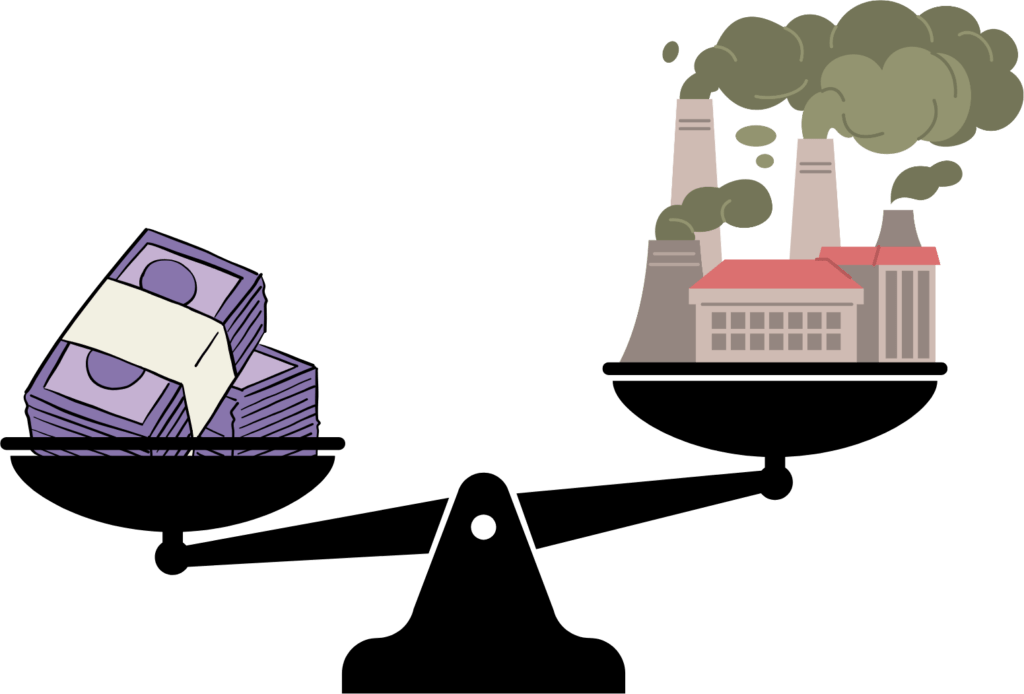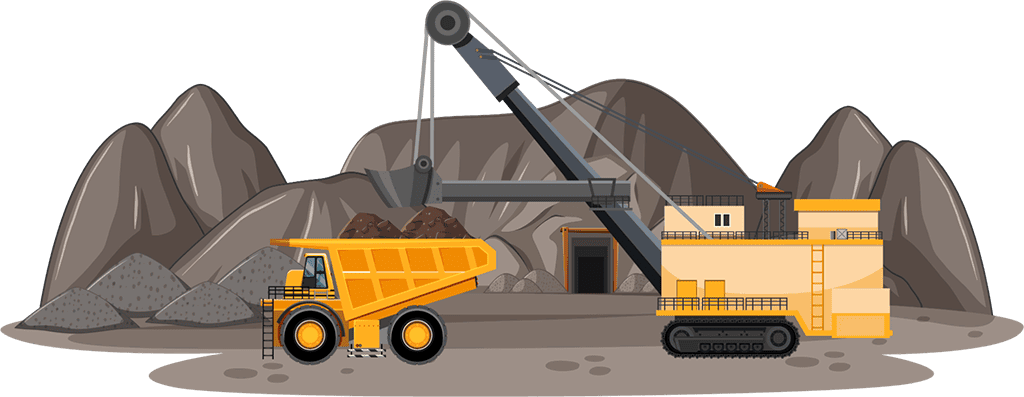
South Africa has an extensive natural endowment of good quality coal that has historically served us well for power generation, industrial use and exports. It is an energy dense fuel that is easy to mine and use. Over 85% of our electricity generation comes from coal-fired power plants, and over 110 000 people directly and indirectly employed in Coal.
Burning coal causes high levels of air pollution and CO2 emissions. Most of our coal power stations rely on outdated technology, are inefficient, and come with rapidly rising operational costs.
Eskom has spent a lot of money on fixing our coal stations and have done well to end load shedding, but the years of bad maintenance and loss of critical skills under State Capture and Covid are still having an impact. This directly affects you and all other South Africans as we need to work that much harder to control the CO2 emissions and #EnergizeMzansi.
One of the strongest arguments for decreasing our dependence on coal-fired power stations is the impact they have on the atmosphere.

Further, coal combustion is highly emissions-intensive: coal-fired electricity generation is responsible for 32% of global greenhouse gas emissions as well as deadly air pollution which is measured in sulfur oxides (Sox), nitrogen oxides (Nox) and particulates.
Even the most conservative estimates suggest that coal-fired power generation is responsible for over 250,000 deaths globally each year, underscoring its profound impact on your life and the lives of fellow South Africans.
This result is primarily because of air pollution that causes heart disease, lung cancer and pneumonia.
There’s also damage to our environment and the planet: high greenhouse gas (GHG) emissions are contributing to climate change, increasing global warming and all its adverse effects.
Coal-fired power generation remains in the South African supply mix until 2073 based on current plans. So how do we provide energy security and job security, but reduce our carbon footprint and health impacts?
IRP 2023
How do we balance making coal-fired power stations more efficient, versus moving to energy sources that are less expensive and don’t pollute the atmosphere?

In power systems across the world, coal provides low-cost, dispatchable, baseload generation in normal operational conditions where there is an Energy Availability Factor (EAF) of more than 70%.
Coal-fired power can ramp up and ramp down to meet demand. But this can only occur over the span of hours, rather than minutes (such as for gas-to-power). It’s the “energy anchor” that keeps chugging away to keep the lights on.
Because our coal fleet is old and has not been maintained properly, we experience a high number of breakdowns and have, until very recently, been operating at an EAF of below 50%. In plain language: they’ve become inefficient and unreliable. Right now, the simplest way to increase electricity supply is to improve how Eskom’s coal power stations operate. However, this will be costly, and it might not make financial sense in a competitive market. To address this, we need a solid plan to improve coal power in a way that avoids wasting money and helps end load shedding.
Further, Eskom’s exemptions from Minimum Emissions Standards (MES) has provided some space to address energy insecurity challenges, however, in the medium term, Eskom’s plants will have to comply with national legislation on air quality and emissions. Full compliance with the Minimum Emissions Standards is projected to cost over R300 bn. This financial burden poses challenges, as it may increase electricity tariffs and require substantial investment, which is difficult to justify for aging and inefficient plants.
The objective of the Just Energy Transition is to shift from a fossil fuel-based energy system to a sustainable, low-carbon one while addressing social, economic, and environmental challenges. It aims to ensure that the transition is fair and inclusive, prioritizing job creation, community development, and support for those most affected, such as workers in traditional energy sectors and vulnerable communities. The goal is to balance sustainability with equity, leaving no one behind.
In summary, addressing the coal agenda in South Africa requires a balanced approach that considers economic, social, and environmental factors. Key discussions should focus on transitioning away from coal while ensuring job creation, energy security, and reducing emissions. This includes supporting coal-dependent communities with reskilling and development, scaling up renewable energy, and attracting investment. A clear, long-term policy framework is needed to drive market reforms, along with international support for climate commitments. By integrating these elements, South Africa can achieve a just and sustainable energy transition and #energisemzansi.
What happens to the coal-fired power stations and the people whose jobs depend on them – whether they work in a coal mine, a power station, or the surrounding community?

Is the solution to make coal-fired power stations more efficient? And if so, where’s the money going to come from?
Eskom will need R340-billion to comply with Minimum Emissions Standards (MES). Some of the money could come from the International Partners Group, a global alliance of countries that is dedicated to supporting the Just Transition. Some would need to come from the private sector.

It’s important to understand what will make these investments attractive to the private sector, particularly given the uncertainty around the long-term future of coal-fired power stations.
The other hard number to bear in mind is the 110 000 people who are employed, directly and indirectly, in the coal value chain. Guardrails will have to be put in place to make sure that the transition away from coal is, indeed, a Just Transition.
Energy Transition will adversely affect coal communities, which are concentrated in the northeast.
Coal mining regions in the northeast at risk to be hardest hit from local & global decarbonization
But risk even higher: On average, one mine worker supports ~5-10 dependents1
Best RE potential along the coast: potentially causing forced labor migration
111k direct & indirect jobs (0,6% of SA employment) at risk
1. SA mining industry average for # of dependents per worker
Source: Stats SA, Minerals Council South Africa, NBI, South Africa’s Transition to Net-Zero
##EnergiseMzansi
We need to make some crucial decisions around coal

Physical Address:
12 Desmond Street,
Kramerville, 2090, South Africa
Enquiries:
Email: info@energycouncil.org.za
© 2025 Energy Council of South Africa.
All rights reserved | Privacy Policy | Fraud and Unethical Conduct
| Cookie | Duration | Description |
|---|---|---|
| cookielawinfo-checkbox-analytics | 11 months | This cookie is set by GDPR Cookie Consent plugin. The cookie is used to store the user consent for the cookies in the category "Analytics". |
| cookielawinfo-checkbox-functional | 11 months | The cookie is set by GDPR cookie consent to record the user consent for the cookies in the category "Functional". |
| cookielawinfo-checkbox-necessary | 11 months | This cookie is set by GDPR Cookie Consent plugin. The cookies is used to store the user consent for the cookies in the category "Necessary". |
| cookielawinfo-checkbox-others | 11 months | This cookie is set by GDPR Cookie Consent plugin. The cookie is used to store the user consent for the cookies in the category "Other. |
| cookielawinfo-checkbox-performance | 11 months | This cookie is set by GDPR Cookie Consent plugin. The cookie is used to store the user consent for the cookies in the category "Performance". |
| viewed_cookie_policy | 11 months | The cookie is set by the GDPR Cookie Consent plugin and is used to store whether or not user has consented to the use of cookies. It does not store any personal data. |
A Power Purchase Agreement (PPA) is a long-term contract between a buyer and a supplier of electricity that defines the terms of the agreement.
Multi-market system – a hybrid market model designed to accommodate various defined transactions (market transactions, physical bilateral transactions and regulated transactions).
Scheduling supply to meet current demand for electricity
Electricity storage encompasses all technologies that can consume electricity (e.g., charge in times of oversupply) and return it later (e.g., discharge in times of undersupply).
The capacity factor is the ratio of the actual electrical energy output over a certain period of time to the maximum possible output if the power source was operating at full capacity all the time. Essentially, it illustrates the efficiency and dependability of an energy source.
A transmission grid is an interconnected network of electrical transmission lines that moves electricity from power plants to distribution systems and end users
Variable renewable energy (VRE) or intermittent renewable energy sources (IRES) are renewable energy sources that are not adjustable due to their fluctuating nature, such as wind power and solar power
Capital costs are fixed, one-time expenses incurred on the purchase of equipment used in the production of goods
The cost added by producing one additional unit of a product or service.
Renewable energy refers to energy generated from a source that is not depleted when used
Liquefied natural gas (LNG) is natural gas that has been cooled down to liquid form for ease and safety of non-pressurized storage or transport.
Republic of Mozambique Pipeline Investments Company
A petajoule (PJ) is a unit of energy measurement that is equal to one million billion joules (10 to the power 15). It can also be expressed as 278 gigawatt hours. One petajoule is equal to 31.60 million cubic meters of natural gas.
Dispatchable generation refers to sources of electricity that can be programmed on demand at the request of power grid operators, according to market needs. Dispatchable generators may adjust their power output according to an order.
Domestic gas is natural gas found underground within a county’s borders
Energy Availability Factor (EAF) = measure of generation performance, electricity available to be generated. EAF is the difference between the maximum availability and all unavailabilities expressed as a percentage
Particulates are microscopic particles of solid or liquid matter suspended in the air. Sources of particulate matter can be natural or anthropogenic. They have impacts on climate and precipitation that adversely affect human health, in ways additional to direct inhalation.
Nitric oxide (NO) and nitrogen dioxide (NO2) are two gases whose molecules are made of nitrogen and oxygen atoms. These nitrogen oxides contribute to the problem of air pollution, playing roles in the formation of both smog and acid rain. They are released into Earth’s atmosphere by both natural and human-generated sources.
Sulfur oxides are a group of molecules made of sulfur and oxygen atoms, such as sulfur dioxide (SO2) and sulfur trioxide (SO3). Sulfur oxides are pollutants that contribute to the formation of acid rain, as well as particulate pollution. Some are released into Earth’s atmosphere by natural sources, but most are the result of human activities.
Net Zero means cutting carbon emissions to a small amount of residual emissions that can be absorbed and durably stored by nature and other carbon dioxide removal measures, leaving zero in the atmosphere.
Nationally Determined Contributions are the commitments that countries make to reduce their greenhouse gas emissions as part of climate change mitigation.
The Paris Agreement is a legally binding international treaty on climate change. It was adopted by 196 Parties at the UN Climate Change Conference (COP21) in Paris, France, on 12 December 2015.
The energy trilemma is a framework that energy policymakers use to balance three objectives:
likely to receive funding
The EU’s Carbon Border Adjustment Mechanism (CBAM) is the EU’s tool to put a fair price on the carbon emitted during the production of carbon intensive goods that are entering the EU, and to encourage cleaner industrial production in non-EU countries
An integrated system brings together several elements to create single cohesive unit
Green hydrogen is hydrogen produced by the electrolysis of water, using renewable electricity. Production of green hydrogen causes significantly lower greenhouse gas emissions than production of grey hydrogen, which is derived from fossil fuels without carbon capture.